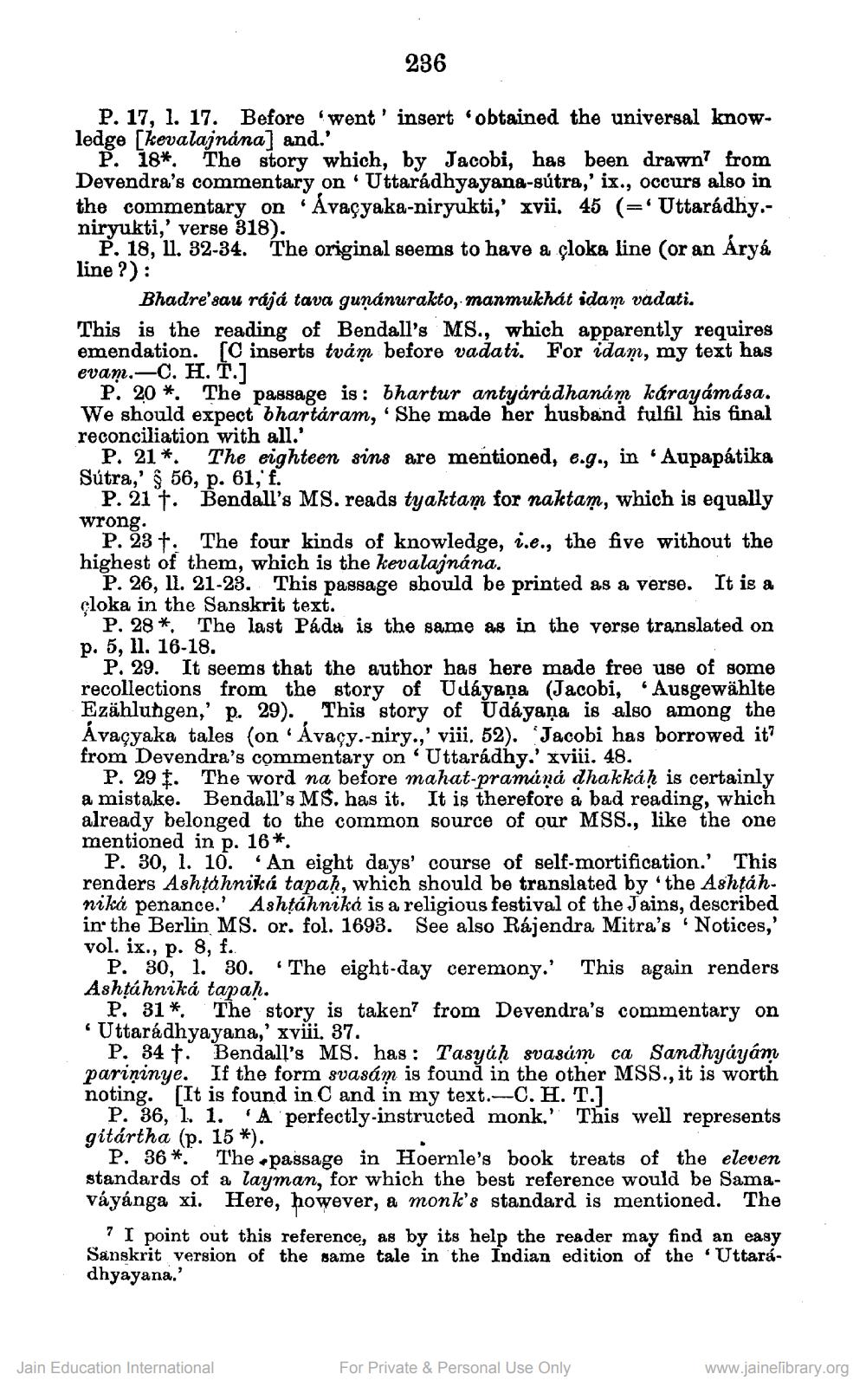________________
236
0-10,
P. 17, 1. 17. Before 'went' insert 'obtained the universal knowledge kevalajnána and.'
P. 18*. The story which, by Jacobi, has been drawn? from Devendra's commentary on · Uttaradhyayana-sútra,' ix., occurs also in the commentary on Avaçyaka-niryukti, xvii. 45 (= Uttaradhyniryukti,' verse 318).
P. 18, 11. 32-34. The original seems to have a çloka line (or an áryá line ?):
Bhadre'sau rájá tava guņánurakto, manmukhát idam vadati. This is the reading of Bendall's MS., which apparently requires emendation. [C inserts tvåm before vadati. For idam, my text has evan.-C. H. Ť.]
P. 20 *. The passage is : bhartur antyárádhanám kárayámása. We should expect bhartáram, She made her husband fulfil his final reconciliation with all.'
P. 21*. The eighteen sins are mentioned, e.g., in Aupapátika Sútra,' $ 56, p. 61, f.
P. 21 +. Bendall's MS. reads tyaktam for naktam, which is equally wrong.
P. 23 +. The four kinds of knowledge, i.e., the five without the highest of them, which is the kevalajnána.
P. 26, II. 21-23. This passage should be printed as a verse. It is a cloka in the Sanskrit text.
P. 28*. The last Páda is the same as in the verse translated on p. 5, 11. 16-18.
P. 29. It seems that the author has here made free use of some recollections from the story of Udayana (Jacobi, Ausgewählte Ezählungen,' p. 29). This story of Udayana is also among the Ávaçyaka tales (on Ávacy.-niry.,' viii. 52). Jacobi has borrowed it? from Devendra's commentary on 'Uttaradhy,' xviii. 48.
P. 29. The word na before mahat-pramáná dhakkák is certainly a mistake. Bendall's MS. has it. It is therefore a bad reading, which already belonged to the common source of our MSS., like the one mentioned in p. 16*.
P. 30, 1. 10. "An eight days' course of self-mortification. This renders Ashtáhniká tapah, which should be translated by the Ashțáh. niká penance.' Ashtáhniká is a religious festival of the Jains, described in the Berlin MS. or. fol. 1693. See also Rájendra Mitra's Notices, vol. ix., p. 8, f.
P. 30, 1. 30. The eight-day ceremony. This again renders Ashtáhniká tapah.
P. 31*. The story is taken? from Devendra's commentary on Uttaradhyayana,' xviii. 37.
P. 34 f. Bendall's MS. has: Tasyúh svasúm ca Sandhyayam pariņinye. If the form svasám is found in the other MSS., it is worth noting. It is found in C and in my text.-C.H. T.]
P. 36, 1. 1. 'A perfectly-instructed monk.' This well represents gitártha (p. 15 *).
P. 36 *. The passage in Hoernle's book treats of the eleven standards of a layman, for which the best reference would be Samaváyánga xi. Here, however, a monk's standard is mentioned. The
? I point out this reference, as by its help the reader may find an easy Sanskrit version of the same tale in the Indian edition of the Uttarádhyayana.'
Jain Education International
For Private & Personal Use Only
www.jainelibrary.org




